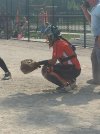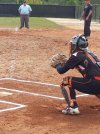How my daughter is taught by her catching instructor is there is primary and secondary stance. Secondary stance is when there are runners on. However, it more relates to the position of her rear end - NOT her whole body. When in primary stance, the rear end can be down more in the squat. When in secondary, you lift the butt up to where the thighs are basically a straight line, horizontal to the ground. But it is really important to NOT raise up your upper body because it can impede the ump's view of the strike zone - you still want her overall position to be low. So, really what sort of happens (especially as the girls get older and taller) is the upper body and shoulders sort of lean forward and stay low. The upper body does not just stay straight in the air, perpendicular to the ground. Coming up into secondary stance helps to unlock your knees and hips for an overall quicker pop time - but again, it is important to stress to keep the upper body low in the stance.
Hope this helps - and that I upload the pictures correctly

The first one is more like her primary stance when no runners are on. In the picture she is actually looking at where the batter is setting up and about to give a signal, so it's not a perfect example, but it is similar to her primary stance as far as how her legs and bottom are. The second picture is during the game while in her secondary stance. Notice that her thigh is more straight back and her upper body is leaning more....
View attachment 993
View attachment 994


